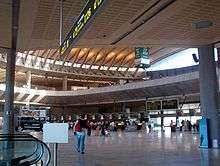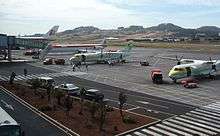Tenerife-North Airport
| Tenerife North Airport Aeropuerto de Tenerife Norte | |||||||||||
|---|---|---|---|---|---|---|---|---|---|---|---|
 | |||||||||||
| Summary | |||||||||||
| Airport type | Public | ||||||||||
| Owner | Aena | ||||||||||
| Operator | Aena | ||||||||||
| Serves | Tenerife | ||||||||||
| Location | San Cristóbal de La Laguna | ||||||||||
| Elevation AMSL | 633 m / 2,077 ft | ||||||||||
| Coordinates | 28°28′58″N 016°20′30″W / 28.48278°N 16.34167°WCoordinates: 28°28′58″N 016°20′30″W / 28.48278°N 16.34167°W | ||||||||||
| Website | aena-aeropuertos.es | ||||||||||
| Map | |||||||||||
 TFN Location of airport in Canary Islands | |||||||||||
| Runways | |||||||||||
| |||||||||||
| Statistics (2015) | |||||||||||
| |||||||||||
Tenerife North Airport (IATA: TFN, ICAO: GCXO), formerly Los Rodeos Airport, is one of the two international airports on the island of Tenerife, Spain. It is located in San Cristóbal de La Laguna, 11 km (6.8 mi) by road from Santa Cruz and at an altitude of 633 metres (2,077 ft). It handled 3,717,944 passengers in 2012. Combined with Tenerife–South Airport, the island gathers the highest passenger movement of all the Canary Islands, with 12,248,673 passengers,[1] surpassing Gran Canaria Airport. Today TFN is an inter-island hub connecting all seven of the main Canary Islands with connections to the Iberian Peninsula, Europe, and North America.
In 1977, the airport was the site of the worst accident in aviation history when 583 passengers and crew were killed after two Boeing 747s collided on the runway in heavy fog.
History
Early years
Many years before the airport had even been built, the field at Los Rodeos was hastily prepared to accommodate the first (though unofficial) flight into Tenerife operated by an Arado VI (D-1594) aircraft operating from Berlin on behalf of Deutsche Luft Hansa.
In May 1930, the Compañía de Líneas Aéreas Subvencionadas S.A. (C.L.A.S.S.A.) established the first air link between the Spanish mainland and the Canary Islands using a Ford 4-AT Trimotor (M-CKKA), which took off from Getafe, Madrid to the Los Rodeos field via Casablanca, Cape Juby and Gando in Gran Canaria.
After the final location of the airport had been decided, funds were gathered between 1935 and 1939 to build a small hangar and begin expanding the airstrip which would become Los Rodeos. In July 1936 Francisco Franco did not fly from here after taking over the island to invade the mainland Spain. He flew from Gando (Gran Canaria), in a DH-89 Dragon Rapide chartered to the British company Olley Air Service.
Operations into Los Rodeos recommenced on 23 January 1941 with a De Havilland DH89A Dragon Rapide operating an Iberia flight from Gando in Gran Canaria. By 1946, more hangars, a passenger terminal and an 800 m (2,625 ft) paved runway had been built, and the airport was officially opened to all national and international traffic. The runway was stretched at various times during the 1940s and 1950s, reaching a length of 2,400 m (7,874 ft) in 1953, by which time the airport was also equipped with runway edge lighting and an air-ground radio, enabling night operations.
Development since the 1960s
By 1964, runway 12/30 had been stretched to 3,000 m (9,843 ft) to accommodate the DC-8, new navigation aids were installed, and the apron was expanded to provide more parking spaces for aircraft. In 1971, with the prospect of the Boeing 747 flying into the airport, the runway was reinforced and an ILS (Instrument Landing System) was installed.
In the 1977 Tenerife disaster, a Pan Am Boeing 747 and a KLM Boeing 747 collided on the runway, killing 583 people, the highest number of fatalities (excluding ground fatalities) of any single accident in aviation history. In response, a new airport, Tenerife South Airport, was inaugurated on November 6, 1978. It is situated at sea level which averts the occurrence of fog, one of the reasons for the crash.
A new terminal was inaugurated in 2002, comprising car park, motorway access ramps, and four-story terminal building, with 12 gates. The airport regained its international status when flights to Caracas began. An inter-island domestic area was opened in 2005.
Airlines and destinations



_AN1016572.jpg)
Passenger
The following airlines operate regular scheduled and charter flights to and from Tenerife-North:[3]
| Airlines | Destinations |
|---|---|
| Air Europa | Barcelona, Bilbao, Madrid, Málaga, Seville Seasonal: Alicante, Santiago de Compostela |
| Alitalia | Seasonal: Rome-Fiumicino |
| Binter Canarias & NAYSA | Dakar, El Hierro, Fuerteventura, Gran Canaria, La Gomera, La Palma, Lanzarote, Marrakech Seasonal: Agadir, Funchal |
| CanaryFly | Gran Canaria, La Palma, Lanzarote |
| Finnair | Seasonal: Helsinki |
| Iberia operated by Air Nostrum | Seasonal: Pamplona, Santiago de Compostela, Valencia |
| Iberia Express | Asturias, Madrid |
| Norwegian Air Shuttle | Barcelona, Madrid |
| Royal Air Maroc operated by Royal Air Maroc Express | Casablanca |
| Ryanair | Barcelona, Madrid |
| Vueling | Alicante, Barcelona, Bilbao, Málaga, Paris-Orly, Santiago de Compostela, Seville, Zaragoza |
Cargo
| Airlines | Destinations |
|---|---|
| Swiftair | Madrid |
Statistics
 |
| Updated: 31 March 2016. |
| Passengers | Aircraft movements | Cargo (tonnes) | |
|---|---|---|---|
| 2000 | 2,411,100 | 48,902 | 22,462 |
| 2001 | 2,511,277 | 49,132 | 21,060 |
| 2002 | 2,486,227 | 48,785 | 21,148 |
| 2003 | 2,919,087 | 53,718 | 23,842 |
| 2004 | 3,368,988 | 56,592 | 23,647 |
| 2005 | 3,754,513 | 60,235 | 22,163 |
| 2006 | 4,025,601 | 65,297 | 23,193 |
| 2007 | 4,125,131 | 65,843 | 25,169 |
| 2008 | 4,236,615 | 67,800 | 20,781 |
| 2009 | 4,054,147 | 62,776 | 18,304 |
| 2010 | 4,051,155 | 61,607 | 15,918 |
| 2011 | 4,095,103 | 62,590 | 15,745 |
| 2012 | 3,717,944 | 55,789 | 14,778 |
| 2013 | 3,524,470 | 49,289 | 13,493 |
| 2014 | 3,633,030 | 52,694 | 13,991 |
| 2015 | 3,815,315 | 53,259 | 12,819 |
| Source: AENA[4] | |||
Accidents and incidents
Tenerife airport disaster
Tenerife North Airport was the scene of the Tenerife airport disaster, to date the worst accident in aviation history. The accident took place on 27 March 1977, while during take-off, KLM Flight 4805 a Boeing 747-206B crashed into a Boeing 747-121 of Pan Am Flight 1736 taxiing along the runway. Amongst the passengers and crew of the two aircraft, all 248 passengers on board the KLM flight were killed along with 335 on board the Pan Am flight but 61 people on the Pan Am flight survived. The total death toll was 583 people. Neither flight was originally scheduled to be at the airport; both were scheduled to land at Gran Canaria Airport, but had been diverted to Tenerife North (then Tenerife Los Rodeos) as a result of a bombing at Gran Canaria.
Other incidents
| Date | Airline | Aircraft type | Registration | Flight number | People on board | Fatalities |
|---|---|---|---|---|---|---|
| 1956-09-29 | Aviaco | SNCASE Languedoc | EC-AKV | 38 | 0+1 | |
| 1965-05-05 | Iberia | Lockheed L-1049G | EC-AIN | 401 | 49 | 30 |
| 1965-12-07 | Spantax | Douglas DC-3 | EC-ARZ | 32 | 32 | |
| 1970-01-05 | Iberia | Fokker F-27 Friendship 600 | EC-BOD | 49 | 0 | |
| 1972-12-03 | Spantax | Convair CV-990 | EC-BZR | 275 | 155 | 155 |
| 1980-04-25 | Dan-Air | Boeing 727-46 | G-BDAN | 1008 | 146 | 146 |
References
- 1 2 AENA statistics for 2012
- ↑ EAD Basic
- ↑ aena.es - Destinos (Spanish) retrieved 24 November 2016
- ↑
External links
![]() Media related to Tenerife North Airport at Wikimedia Commons
Media related to Tenerife North Airport at Wikimedia Commons
- Official website (in English) (in Spanish)
- Airlines Pilot Association (ALPA) Article on 1977 KLM-PanAm disaster